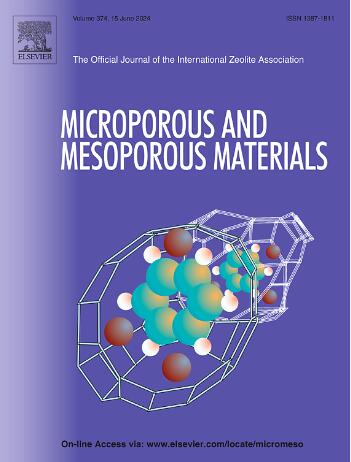研究硝基醇反应和缩合的协同相互作用:阐明微孔隙度和孔径对介孔氨基二氧化硅材料催化活性的影响
IF 4.7
3区 材料科学
Q1 CHEMISTRY, APPLIED
引用次数: 0
摘要
介孔氨基二氧化硅材料是硝基醛反应的活性和选择性非均相催化剂,具有许多物理和结构特性,可以调整到所需的效果。前人研究了调节孔径对硝基醇反应催化活性的影响,发现平均孔径为4.5 nm的MCM-41载体的催化活性最高。我们现在的理解表明,这些结果可能受到材料之间微孔率差异的影响,破坏了非微孔MCM-41和已知具有微孔的SBA-15之间的比较。在这项工作中,我们介绍了一系列可忽略微孔隙度和可变孔径的SBA-15支架。与典型的SBA-15合成相比,由于微孔隙率降低,这些材料表现出更高的催化活性。有趣的是,孔径为7.1 nm的材料在微孔体积减小的sba -15型材料中具有最高的活性。这与MCM-41材料记录的催化活性相似,表明孔径的影响不如微孔隙率的影响重要。由于SBA-15比MCM-41具有更强的水热稳定性,因此在微孔隙度降低的情况下,将其作为硝基醇反应的合适替代品,对未来的开发具有鼓舞作用。本文章由计算机程序翻译,如有差异,请以英文原文为准。

Investigating cooperative interactions for the nitroaldol reaction and condensation: Clarifying the impact of microporosity and pore size on catalytic activity of mesoporous aminosilica materials
Mesoporous aminosilica materials are active and selective heterogeneous catalysts for the nitroaldol reaction and have many physical and structural characteristics that can be tuned to desired effects. Previous work investigated the impact of tuning pore diameter on catalytic activity in the nitroaldol reaction and observed the highest activity with an MCM-41 support containing pores with an average diameter of 4.5 nm. Our understanding now suggests that these results may have been influenced by differences in microporosity between materials, undermining a comparison between non-microporous MCM-41 and SBA-15 that is known to have micropores. In this work, we introduce a line of SBA-15 supports with negligible microporosity and varied pore diameter. Compared to typical syntheses of SBA-15, these materials show increased catalytic activity as a result of decreased microporosity. Interestingly, a material with a pore diameter of 7.1 nm yields the highest activity among SBA-15-type materials with reduced micropore volume. This is similar to the catalytic activity recorded with an MCM-41 material, suggesting that perceived effects of pore diameter are less important than effects of microporosity. Since SBA-15 is more hydrothermally stable than MCM-41, the ability to use it as a suitable alternative for the nitroaldol reaction when microporosity is reduced is encouraging for future development.
求助全文
通过发布文献求助,成功后即可免费获取论文全文。
去求助
来源期刊

Microporous and Mesoporous Materials
化学-材料科学:综合
CiteScore
10.70
自引率
5.80%
发文量
649
审稿时长
26 days
期刊介绍:
Microporous and Mesoporous Materials covers novel and significant aspects of porous solids classified as either microporous (pore size up to 2 nm) or mesoporous (pore size 2 to 50 nm). The porosity should have a specific impact on the material properties or application. Typical examples are zeolites and zeolite-like materials, pillared materials, clathrasils and clathrates, carbon molecular sieves, ordered mesoporous materials, organic/inorganic porous hybrid materials, or porous metal oxides. Both natural and synthetic porous materials are within the scope of the journal.
Topics which are particularly of interest include:
All aspects of natural microporous and mesoporous solids
The synthesis of crystalline or amorphous porous materials
The physico-chemical characterization of microporous and mesoporous solids, especially spectroscopic and microscopic
The modification of microporous and mesoporous solids, for example by ion exchange or solid-state reactions
All topics related to diffusion of mobile species in the pores of microporous and mesoporous materials
Adsorption (and other separation techniques) using microporous or mesoporous adsorbents
Catalysis by microporous and mesoporous materials
Host/guest interactions
Theoretical chemistry and modelling of host/guest interactions
All topics related to the application of microporous and mesoporous materials in industrial catalysis, separation technology, environmental protection, electrochemistry, membranes, sensors, optical devices, etc.
 求助内容:
求助内容: 应助结果提醒方式:
应助结果提醒方式:


